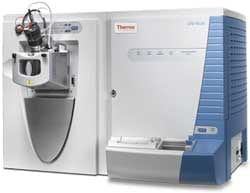Instrument Hub
Overview
The LTQ linear ion trap is a low to modest resolution instrument with a wide array of ionization sources including ESI, NanoESI, APCI, and APPI. It is equipped with HPLC and a selection of columns are available, mainly for higher flow rate work (e.g. 300ul/min) than the QSTAR or TripleTOF 6600. The MSn capability (i.e. multiple rounds of fragmentation are possible) makes this instrument best suited for profiling low MW species (discovery or targetted work) or non-demanding protein identifications. Intact protein MW determinations are possible for simple samples containing reasonable protein concentrations.
Features
- Mass Range: 50-4000 m/z
- Up to 10 MS/MS events
- Selected and Consecutive Reaction Monitoring
- Multiple Ionization Sources: ESI, NanoESI, APCI, APPI
Software
Analysis for the LTQ Ion Trap is supported by the following software:
- Xcalibur
- ProteomeDiscoverer
- PEAKS
- UniDec
Access to the above software is available in the analysis suite. Contact Martin Middleditch for more information.
Support
Email Martin Middleditch for all enquiries related to the LTQ Ion Trap MS.
Considerations
- Sample preparation protocols for each project should preferably be discussed beforehand for quality data analysis.
- Sample preparation involving serum albumin should be avoided where possible as the albumin can suppress other scarce proteins/peptides.
- While LC-MS does deal with some level of salts, it is best to minimise concentrations of non-volatile buffers.
- It is best if no detergents are used during sample prep, or extensive steps taken to massively reduce their concentration in the final extract.
- This instrument is not housed in a PC1 area and only non-hazardous samples are allowed to be transported to and analyzed in the laboratory.
Limitations
- Modest spectral resolution compared to other instruments.
- Not as fast MS/MS acquisition rate as the TripleTOF.
- No loading pump for desalting samples on a trap column; however, a divert valve exists to direct the unretained loading flowthrough to waste for a set time.
- CID is the only fragmentation process available.
Cost
The cost varies depending on task and support level required. Current user costs are listed in iLab booking system.
Eligibility
Available for postgraduate students, doctoral candidates and staff of the University of Auckland. External users and commercial users are also eligible to use the equipment.
Access Requirements
The LTQ Ion Trap is housed on the Main Campus in the School of Biological Sciences.
Training
This instrument is available for self-use. Users are required to undergo training (provided) before using the equipment. Training is booked through iLab.
Booking
Trained users can book the LTQ Ion Trap through Auckland Science Analytical Services (ASAS) iLab booking system. Users and their principal investigators or research group need to first have accounts in the iLab booking system. Instructions, details and FAQs on how to sign up to iLab can be found on the ASAS website.

